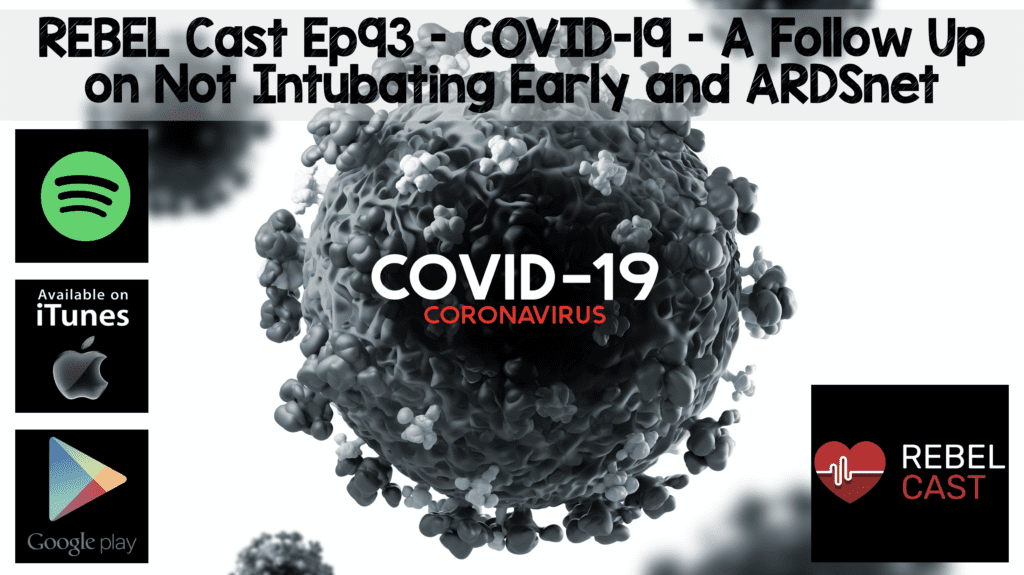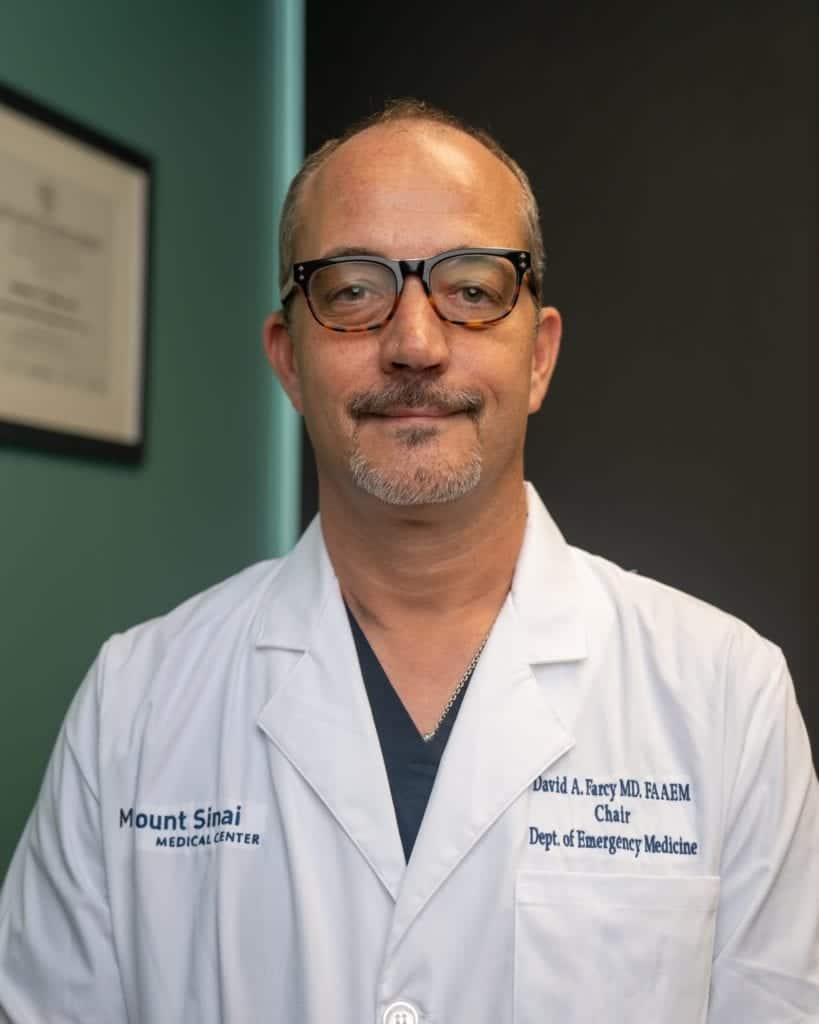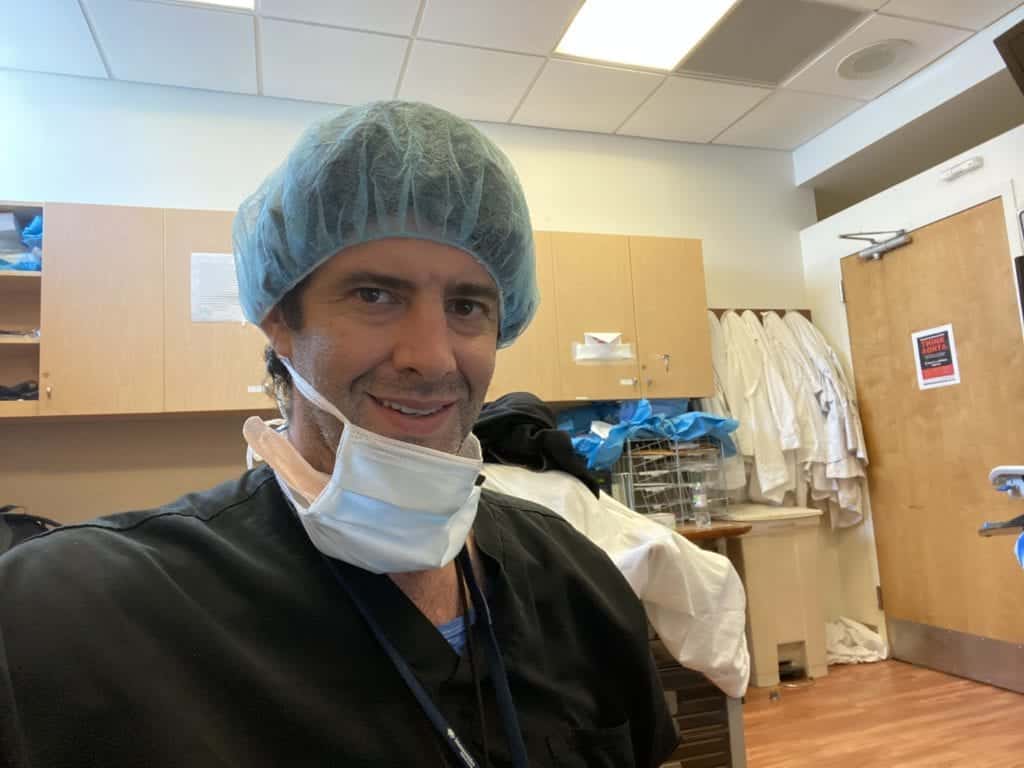
 Back in April 2020, on REBEL Cast episode 79 we sat down to discuss COVID-19. Specifically, we focused on not intubating patients early and why ARDSnet may not be the best ventilator paradigm for patients with COVID-19. By popular demand, we decided to follow up on this podcast. We are now just about 9 months since we recorded this podcast and I wanted to sit down with the same group and see if they had any amendments, they wanted to make regarding what we discussed.
Back in April 2020, on REBEL Cast episode 79 we sat down to discuss COVID-19. Specifically, we focused on not intubating patients early and why ARDSnet may not be the best ventilator paradigm for patients with COVID-19. By popular demand, we decided to follow up on this podcast. We are now just about 9 months since we recorded this podcast and I wanted to sit down with the same group and see if they had any amendments, they wanted to make regarding what we discussed.
REBEL Cast Ep93: COVID-19 – A Follow Up on Not Intubating Early and ARDSnet
Special Guests:

David A. Farcy MD, FAAEM, FACEP, FCCM
Immediate Past President of the American Academy of Emergency Medicine
Chairman, Department of Emergency Medicine
Director, Emergency Medicine Critical Care
Mount Sinai Medical Center
Miami Beach, FL
Twitter: @DFarcy

Evie Marcolini, MD, FAAEM, FACEP, FCCM
Associate Professor of Emergency Medicine and Neurocritical Care
Geisel School of Medicine at Dartmouth, Hanover, New Hampshire
Board of Directors, American Academy of Emergency Medicine
Twitter: @EvieMarcolini

Cameron Kyle-Sidell, MD
Critical Care Medicine
Emergency Medicine
Maimonides Medical Center
Brooklyn, NY
Twitter: @cameronks
US Expanded Access Program:
- Paper: Joyner MJ et al. Effect of Convalescent Plasma on Mortality Among Hospitalized Patients with COVID-19: Initial Three-Month Experience. medRxiv 2020 [1]
- >1800 hospitals across the US
- > 47k patients enrolled in EAP

Has anything changed regarding the use of high-flow nasal cannula (HFNC) and non-invasive ventilation (NIV)?
- We are keeping more patients on HFNC and not paying as much attention to SpO2
- Despite the fact that HFNC has been proven to be safe, we still see a trend of increased intubations in some other countries
- There is more data on the progression of patients that are not intubated, so we are becoming more comfortable with not intubating early
- Institutions are more comfortable dealing with aerosolization concerns, thus we are more comfortable with the use of NIV
- In the past, we were restricted due to high patient volumes, full ICUs and resource limitations. Now that we have lower numbers of patients, we are better able to weigh the risks and benefits of early intubations
What markers are we using to make our decisions to intubate?
- Before COVID, tachypnea, tachycardia and SpO2 would be used to make decisions about intubation. Now we’ve added other considerations like mental status, diaphoresis and work of breathing
- Patients on HFNC don’t seem to be tiring out the way we would typically expect. There are also discussions about the potential role of a new entity referred to as patient self-induced lung injury (P-SILI)
- The concept is that you can have the same swings in intrapleural pressure with vigorous breathing as you would have with a ventilator. So while the breathing may appear fine, the heavy swings in pressure can cause lung injury. So theoretically, intubating a patient would be protective against this form of lung injury
- Farcy: Our early data shows that patients with severe COVID who were maintained on HFNC without intubation have had length of stays of about 11 days with a 90% success rate. Some reports state that lung injury may be due to microthrombi. There are also some reports of steroids and aspirin decreasing mortality
Thoughts on pathophysiology of COVID-19?
- Regarding the pathophysiology, some intensivists have drawn parallels between COVID and acute fibrinous and organizing pneumonia (AFOP). This is a disease with a slow progression that responds to steroids, but a patient can also suddenly deteriorate. The strategy in AFOP is usually to monitor work of breathing
- Marcolini: Fatui et al also discusses stages of the neurological manifestations of COVID. Applying this framework, we ask ourselves, where is our patient in the progression of the disease
- In the first stage, the virus stays in the nasal passages and there is no cytokine storm or entry into the brain
- In the second stage, you have a cytokine storm that causes inflammation and hypercoagulability in addition to neurologic symptoms
- In the third stage, the cytokine storm explodes, and you have a huge systemic inflammatory response
- Kyle-Sidell: Work of breathing is inherently tied to compliance. Patients that we thought would tire out, don’t, due to having a preserved lung compliance. We have patients with poor P/F ratios, but they have higher tidal volumes than we would expect.
- Through intubation and the use of high PEEP, we are trying to increase recruitment in the lungs. However, in patients with COVID, we are causing over-distension of alveoli which were already damaged due to the vascular effects of COVID. (We now know that this disease is primarily a platelet-driven, endothelial-activated vascular process
- Some people consider COVID a heterogenous disease, however if we put aside the complications, it is relatively uniform in terms of pathophysiology. The heterogeneity is in the time-frames and severities that patients present with. So depending on the time-frame of when the complications present, the management can change. Although best management is not always clear, we do need to take into consideration what is going on in the patients’ lungs and how to best address that
- Farcy: We try to manage patients with HFNC and proning as long as they are mentating appropriately and do not have an increased work of breathing. For those who are intubated, we give steroids and aspirin. With this, we have seen less cytokine storm than in patients that were intubated early. I think the gradual escalation of therapy may have helped curb the severe cytokine storm that is associated with multi-system organ failure in patients with severe disease.
Putting it all together
- Time does matter. COVID is a heterogenous disease because we don’t know what those timeframes are along its natural progression. There is a viremic phase, followed by a pulmonary phase, followed by a hyper-inflammatory phase
- We are mostly seeing patients on days 5 -10 by the time they come in to the ED, which corresponds with the pulmonary phase
- We are in agreement that we should avoid intubating early. But with the added consideration that there may be patient-induced lung injury in patients we manage on HFNC and NIV for too long, a theory that is yet to be proven
- Despite considering COVID an alveolar disease earlier this year, the thinking has now changed to COVID being a vascular disease associated with endothelial injury and platelet hyper-activation. So putting people on high tidal volumes and high PEEP can over-distend damaged alveoli and cause more injury. And this may be one of the reasons for the hyper-inflammatory, multi-organ failure we see in patients that were intubated early
If you had to choose between HFNC and NIV, which would you choose and why?
- HNFC is preferable initially for several reasons:
- BiPAP at high settings is more aerosolizing than HFNC at any setting
- While useful in ARDS due to regional collapse, NIV has not been as useful in COVID because there seems to be a different pathophysiology
- In the absence of helmets, NIV masks are harder to tolerate for patients for a week or more. With nasal cannula, patients can still eat and they are generally more comfortable.
- Marcolini: If a patient is hypoxic, I go with HFNC. If they are hypercarbic, I am thinking about BiPAP
- If a patient on HFNC is found to have significant collapse on CT without consolidation, it would make sense to then progress to NIV.
- Assuming that you have the staff to monitor them appropriately.
It appears that COVID starts with a higher compliance and air-filled alveoli and then transitions to a more traditional ARDS with a lower compliance where recruitment and proning would be helpful. What are your thoughts?
- Although proning appears to improve SpO2, it does not seem to increase recruitment in a significant way. And an additional benefit of repositioning is the shifting of oxygenation and blood flow that potentially prevents ischemia to lung segments
- When proning is typically used in the ICU on non-COVID diseases, we do see some sustained recruitment in the form of improving P/F ratios. In COVID patients, however, that has not been the case
- Kyle-Sidell: I was initially not using NIV partly because we didn’t have negative pressure rooms or staff to watch the patients. But some patients managed with HFNC do progress to a low-compliance, non-recruitable state. These are patients that if stable enough, young enough and at the right center, could be considered for ECMO or lung transplantation
- Proning should still be used at all stages of COVID.
- Early stages: Shifting of blood flow to areas with less damage (COVID most often affects the posterior lower segments)
- Late stages: some beneficial recruitment in the lungs
- Allows for the use of less aggressive interventions with less oxygen and lower pressures
- Farcy: I have some patients being managed at home with HFNC who report dramatic improvements to SpO2 with proning. However, their SpO2 drops again when they leave the prone position.
What are the triggers to intubate? Have they changed since we last talked?
- Kyle-Sidell: The initial threshold we had for intubation was when they required 100% FiO2 to achieve a SpO2 of 88-90% combined with distress (defined as anxiety and tachypnea), or sustained SpO2 levels below 80%. We then learned that when a patient knocks off their nasal cannula and goes down to 29% SpO2, to just leave them there and replace the nasal cannula and let them come up again before getting respiratory therapy involved. The only thing that has changed for me is wondering whether or not I am waiting too long to intubate. I am constantly thinking about whether or not there is a way to protect the patient’s lungs
- We’ve stopped looking at numbers or following SpO2, so no changes to our approach since then
Take-Home Messages:
- Early intubation should still be avoided
- Consider mental status and work of breathing when thinking about intubation
- In a stable patient, HFNC should be attempted first, followed by NIV for patients that require more support
- Proning is still beneficial at all stages of COVID
References:
- Joyner MJ et al. Effect of Convalescent Plasma on Mortality Among Hospitalized Patients with COVID-19: Initial Three-Month Experience. medRxiv 2020. [Epub Ahead of Print]
Transcript By: Yasien Eltigani, MS4 at St. George’s University (Twitter: @yasieneltigani)
Post Peer Reviewed By: Anand Swaminathan, MD (Twitter: @EMSwami)
The post REBEL Cast Ep93: COVID-19 – A Follow Up on Not Intubating Early and ARDSnet appeared first on REBEL EM - Emergency Medicine Blog.
